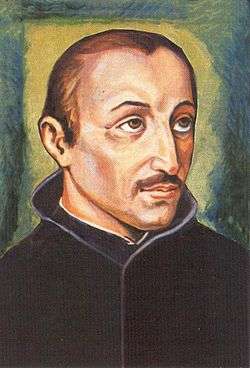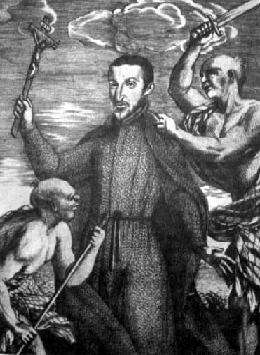Diego Luis de San Vitores
| Blessed Diego Luis de San Vitores | |
|---|---|
 | |
| Priest, Missionary, Martyr | |
| Born |
November 12, 1627 |
| Died |
April 2, 1672 (aged 44) |
| Venerated in | Roman Catholic Church |
| Beatified | October 6, 1985, Vatican by Pope John Paul II |
| Feast | October 6 |
Blessed Diego Luis de San Vitores (November 12, 1627 – April 2, 1672) was a Spanish Jesuit missionary who founded the first Catholic church on the island of Guam. He is responsible for establishing the Spanish presence in the Mariana Islands.
Early life
A son of a nobleman, he was baptised Diego Jerónimo de San Vitores y Alonso de Maluendo. He was born on November 12, 1627 in the city of Burgos, Spain to Don Jerónimo de San Vitores and Doña María Alonso Maluenda. His parents attempted to persuade him to pursue a military career, but San Vitores instead chose to pursue his religious interests. In 1640, he entered the Jesuit novitiate and was ordained a priest in 1651. Believing his calling was to serve as a missionary to non-Christians, San Vitores was granted his request and assigned to a mission in the Philippines.
In 1662, San Vitores, stopped in Guam on the way to the Philippines and vowed to return. Three years later, through his close ties to the royal court, he persuaded King Philip IV of Spain and Queen Maria Ana of Austria to order a mission in Guam be established.
Martyrdom
A Chamorro named Choco, a criminal from Manila who was exiled in Guam began spreading rumours that the baptismal water used by missionaries was poisonous. As some sickly Chamorro infants who were baptized eventually died, many believed the story and held the missionaries responsible. Choco was readily supported by the macanjas (medicine men) and the urritaos (young males) who despised the missionaries.
In their search for a runaway companion named Esteban, San Vitores and his Visayan companion Pedro Calungsod came to the village of Tumon, Guam on 2 April 1672. There they learnt that the wife of the village chief Matapang gave birth to a daughter, and they immediately went to baptise the child. Influenced by the calumnies of Choco, the chief strongly opposed;[1] to give Mata'pang some time to calm down, the missionaries gathered the children and some adults of the village at the nearby shore and started chanting with them the tenets of the Catholic religion. They invited Mata'pang to join them, but he shouted back that he was angry with God and was fed up with Christian teachings.
Determined to kill the missionaries, Mata'pang went away and tried to enlist another villager, named Hurao, who was not a Christian. Hurao initially refused, mindful of the missionaries' kindness towards the natives, but when Mata'pang branded him a coward, he became piqued and capitulated. Meanwhile, during that brief absence of Mata'pang from his hut, San Vitores and Calungsod baptised the baby girl, with the consent of her Christian mother.
When Mata'pang learnt of his daughter's baptism, he became even more furious. He violently hurled spears first at Pedro, who was able to dodge the spears. Witnesses claim that Calungsod could have escaped the attack, but did not want to leave San Vitores alone. Those who knew Calungsod personally meanwhile believed that he could have defeated the aggressors with weapons; San Vitores however banned his companions to carry arms. Calungsod was hit in the chest by a spear and he fell to the ground, then Hurao immediately charged towards him and finished him off with machete blow to the head. San Vitores absolved Calungsod before he too was killed.
Mata'pang took San Vitores' crucifix and pounded it with a stone whilst blaspheming God. Both assassins then denuded the corpses of Calungsod and San Vitores, tied large stones to their feet, brought them out to sea on their proas and threw them into the water.[2]
Mission to Guam
While in Mexico en route to Guam, San Vitores had difficulty encouraging the Spanish Viceroy to fund his mission. However, with his close ties to the court San Vitores was able to secure support for his missionizing campaign. In 1668, Padre Diego Luis de San Vitores set sail from Acapulco to Guam. San Vitores named the Chamorro archipelago, "Islas Marianas" (Mariana Islands) in honour of the Queen Regent of Spain, Maria Ana of Austria, and the Blessed Virgin Mary. The missionary landed on Guam in the village of Hagåtña and was greeted by Chief Kepuha. Kepuha's family donated land to establish the first Catholic mission on Guam. On February 2, 1669 Padre San Vitores established the first Catholic Church in Hagåtña and dedicated it to the sweet name of Mary, "Dulce Nombre de Maria."
After Chief Kepuha's death in 1669, Spanish missionary and Chamorro Nobility relations worsened and the Chamorro - Spanish War began in 1671 led by Chief Hurao. After several attacks on the Spanish mission, a peace was negotiated. Though San Vitores chose to emulate Saint Francis Xavier, who did not use soldiers in his missionization efforts in India, as his model priest, he recognized that a military presence would be necessary to protect the priests serving Guam. In 1672, San Vitores ordered Churches built in four villages, including Merizo. Later that year, Chamorro resistance increased, led by makahnas and kakahnas (indigenous priests and priestesses) from the Chamorri (upper caste) who would lose their leadership position and status under a Roman Catholic mission organisation and male-dominated Spanish society.
Death
On 2 April 1672, Mata'pang and Hurao killed San Vitores and his Visayan assistant, Pedro Calungsod. San Vitores had baptized Mata'pang's newborn daughter without the chief's permission; Mata'pang's wife consented to the baptism according to some accounts. Some records state that Mata'pang had believed holy water used in baptism had caused the recent deaths of babies due to European diseases.
The death of the Spanish mission leader led to Spanish army reprisals against Chamorro chiefs who had decided to defend their power from Spanish subjugation. Bounties were offered for these chiefs and many were hunted down. Under Spanish military governors, Chamorros who were anti-Spanish were massacred in their villages. European plague and warfare eventually contributed to the defeat of the anti-Spanish Chamorros. The Chamorro - Spanish Wars lasted more than 25 years.
Memorials
The San Vitores Martyrdom Site is listed on the U.S. National Register of Historic Places.
Canonization process
This is Fr. Diego Luis de San Vitores' Process for Sainthood.
- Diocese of Competent Bishop: Manila/Agana
- CCS Protocol No: 1414
- Type of Cause:Martyrdom
- Opening of Informative Process: 1688
- Closing of Informative Process: 1689
- Submission of Prositio to CCS: 1981
- Session of Historical Consultants: 24 March 1982
- Particular Meeting of Theological Consultors: 17 April 1984
- Session of Cardinal and Bishop Members of the CCS: 19 June 1984
- Veneration: 9 November 1984
- Beatification: 6 October 1985
- Postulator:
- Petitioner: Jesuits of Micronesia Regional Office, P.O. Box 23142 GMF, Barrigada, 96921-3142, GUAM
See also
- Villages of Guam
- History of Guam
- Tumon
- Pedro Calungsod
- Felipe Songsong
- Nicolas de Figueroa
- Juan de los Reyes
References
- ↑ http://www.vatican.va/holy_father/john_paul_ii/apost_letters/2000/documents/hf_jp-ii_apl_20000305_item-laudem_lt.html Interea, illa infans puellula, christiana eius matre consentiente, sacramentali baptismatis lavacro est abluta. Translation: In the mean time, that an infant girl, Christian with the consent of her mother, cleansed by the washing of sacramental baptism.
- ↑ http://pedrocalungsod.page.tl/Biography.htm
References and external links
- Rogers, Robert F (1995). Destiny's Landfall: A History of Guam: University of Hawai'i Press. ISBN 0-8248-1678-1
- Carter, Lee D; Carter, Rosa Roberto; Wuerch, William L (1997). Guam History: Perspectives Volume One: MARC. ISBN 1-878453-28-9
- Risco, Alberto (1970). The apostle of the Marianas: The life, labors, and martyrdom of Ven. Diego Luis de San Vitores, 1627-1672:
Diocese of Agana. ASIN: B0006EOYJS
- Chief Kepuha
- Blessed Diego - Archdiocese of Agana
- Blessed Diego Luis de San Vitores church, Guam, USA
